An Integrated Method for Coding Trees, Measuring Tree Diameter, and Estimating Tree Positions
Abstract
1. Introduction
2. Technology and Theory
2.1. Design of the Main Device
2.2. Technology of Coding Trees
2.3. Angle Calculation
2.4. Double-Sided Two-Way Ranging
3. Materials and Methods
3.1. Study Area
3.2. Methods
3.2.1. The System Workflow
3.2.2. The Operation Workflow
3.2.3. Measurement Algorithm of a Tree’s DBH
3.2.4. Estimation Algorithm of a Tree Position
3.2.5. Evaluation of the Accuracy of the DBH and Tree Position
4. Results
4.1. Tree Identification
4.2. Evaluation of DBH
4.3. Evaluation of Tree Position
5. Discussion
6. Conclusions
Author Contributions
Funding
Conflicts of Interest
References
- Mikita, T.; Janata, P.; Surovỳ, P. Forest stand inventory based on combined aerial and terrestrial close-range photogrammetry. Forests 2016, 7, 165. [Google Scholar] [CrossRef]
- Trumbore, S.; Brando, P.; Hartmann, H. Forest health and global change. Science 2015, 349, 814–818. [Google Scholar] [CrossRef] [PubMed]
- MacDicken, K.G. Global forest resources assessment 2015: What, why and how? For. Ecol. Manag. 2015, 352, 3–8. [Google Scholar] [CrossRef]
- Fan, Y.; Feng, Z.; Mannan, A.; Ullah Khan, T.; Shen, C.; Saeed, S. Estimating tree position, diameter at breast height, and tree height in real-time using a mobile phone with RGB-D SLAM. Remote Sens. 2018, 10, 1845. [Google Scholar] [CrossRef]
- Reutebuch, S.E.; Andersen, H.-E.; McGaughey, R.J. Light detection and ranging (LIDAR): An emerging tool for multiple resource inventory. J. For. 2005, 103, 286–292. [Google Scholar]
- Jenkins, C.; Chojnacky, D.; Heath, L.; Birdsey, R. Comprehensive Database of Diameter-Based Biomass Regressions for North American Tree Species; US Department of Agriculture, Forest Service, Northeastern Research Station: Newtown Square, PA, USA, 2004.
- Bauwens, S.; Fayolle, A.; Gourlet-Fleury, S.; Ndjele, L.M.; Mengal, C.; Lejeune, P. Terrestrial photogrammetry: A non-destructive method for modelling irregularly shaped tropical tree trunks. Methods Ecol. Evol. 2017, 8, 460–471. [Google Scholar] [CrossRef]
- Liang, X.; Kankare, V.; Hyyppä, J.; Wang, Y.; Kukko, A.; Haggrén, H.; Yu, X.; Kaartinen, H.; Jaakkola, A.; Guan, F.; et al. Terrestrial laser scanning in forest inventories. ISPRS J. Photogramm. Remote Sens. 2016, 115, 63–77. [Google Scholar] [CrossRef]
- Ville, L.; Ninni, S.; Michael, A.W.; White, J.; Vastaranta, M.; Holopainen, M.; Hyyppä, J. Assessing precision in conventional field measurements of individual tree attributes. Forests 2017, 8, 38. [Google Scholar]
- Clark, N.A.; Wynne, R.H.; Schmoldt, D.L. A review of past research on dendrometers. For. Sci. 2000, 46, 570–576. [Google Scholar]
- Kellogg, R.M.; Barber, F.J. Stem eccentricity in coastal western Hemlock. Can. J. For. Res. 1981, 11, 715–718. [Google Scholar] [CrossRef]
- Matérn, B. On the shape of the cross-section of a tree stem. In An Empirical Study of the Geometry of Mensurational Methods; Sveriges lantbruksuniversitet: Umea, Sweden, 1990. [Google Scholar]
- Williamson, R.L. Out-of-roundness in douglas-fir stems. For. Sci. 1975, 21, 365–370. [Google Scholar]
- Wing, M.R.; Knowles, A.J.; Melbostad, S.R.; Jones, A.K. Spiral grain in bristlecone pines (Pinus longaeva) exhibits no correlation with environmental factors. Trees Struct. Funct. 2014, 28, 487–491. [Google Scholar] [CrossRef]
- Shi, P.J.; Huang, J.G.; Hui, C.; Grissino-Mayer, H.D.; Tardif, J.C.; Zhai, L.H.; Wang, F.S.; Li, B.L. Capturing spiral radial growth of conifers using the superellipse to model tree-ring geometric shape. Front. Plant Sci. 2015, 6, 856. [Google Scholar] [CrossRef] [PubMed]
- Sievänen, R.; Godin, C.; DeJong, T.M.; Nikinmaa, E. Functional-structural plant models: A growing paradigm for plant studies. Ann. Bot. 2014, 114, 599–603. [Google Scholar] [CrossRef]
- Cabo, C.; Ordóñez, C.; López-Sánchez, C.A.; Armesto, J. Automatic dendrometry: Tree detection, tree height and diameter estimation using terrestrial laser scanning. Int. J. Appl. Earth Obs. Geoinf. 2018, 69, 164–174. [Google Scholar] [CrossRef]
- Koch, B.; Heyder, U.; Weinacker, H. Detection of individual tree crowns in airborne Lidar data. Photogram. Eng. Remote Sens. 2006, 72, 357–363. [Google Scholar] [CrossRef]
- Tallant, B.; Pelkki, M. A comparison of four forest inventory tools in southeast Arkansas. In Competitiveness of Southern Forest Products Markets in a Global Economy: Trends and Predictions, Proceedings of the Southern Forest Economics Workshop, St. Augustine, FL, USA, 14–16 March 2004; Alavalapati, J.R.R., Carter, D.R., Eds.; University of Florida: Gainesville, FL, USA, 2004; Available online: http://www.sofew.cfr.msstate.edu/papers/0304tallant.pdf (accessed on 31 January 2017).
- Binot, J.M.; Pothier, D.; Lebel, J. Comparison of relative accuracy and time requirement between the caliper, the diameter tape and an electronic tree measuring fork. For. Chron. 1995, 71, 197–200. [Google Scholar] [CrossRef]
- Kangas, A.; Maltamo, M. Forest Inventory: Methodology and Applications; Springer Science & Business Media: Dordrecht, The Netherlands, 2006. [Google Scholar]
- Sun, L.; Fang, L.; Tang, L.; Liu, J. Developing portable system for measuring diameter at breast height. J. B For. Univ. 2018, 40, 82–89. [Google Scholar]
- Jingchen, L.; Zhongke, F.; Yongxiang, F. Automatic measurement of DBH with electronic bar. Trans. Chin. Soc. Agric. Mach. 2017, 48, 1–9. [Google Scholar]
- Haiyang, L.; Zhongke, F.; Hu, N.; Liu, J. Design and experiment of portable high precision equipment for tree diameter measurement. Trans. Chin. Soc. Agric. Mach. 2018, 49, 189–194. [Google Scholar]
- Liang, X.; Hyyppä, J. Automatic stem mapping by merging several terrestrial laser scans at the feature and decision levels. Sensors 2013, 13, 1614–1634. [Google Scholar] [CrossRef] [PubMed]
- Avery, T.E.; Burkhart, H.E. Forest Measurements; McGraw-Hill Cop.: Boston, NY, USA, 2002. [Google Scholar]
- Martin, M.; Jozef, V.; Julián, T.; Grznárová, A.; Valent, P.; Slavík, M.; Merganič, J. High precision individual tree diameter and perimeter estimation from Close-Range photogrammetry. Forests 2018, 9, 696. [Google Scholar] [CrossRef]
- Mokroš, M.; Liang, X.; Surový, P.; Valent, P.; Čerňava, J.; Chudý, F.; Tunák, D.; Saloň, Š.; Merganič, J. Evaluation of Close-Range Photogrammetry Image Collection Methods for Estimating Tree Diameters. ISPRS Int. J. Geo-Inf. 2018, 7, 93. [Google Scholar] [CrossRef]
- Olofsson, K.; Lindberg, E.; Holmgren, J. A method for linking field-surveyed and aerial-detected single trees using cross correlation of position images and the optimization of weighted tree list graphs. In Proceedings of the SilviLaser, Edinburgh, UK, 17–19 September 2008; pp. 95–104. [Google Scholar]
- Lindberg, E.; Holmgren, J.; Olofsson, K.; Olsson, H. Estimation of stem attributes using a combination of terrestrial and airborne laser scanning. In Proceedings of the SilviLaser, Freiburg, Germany, 14–17 September 2010; pp. 1917–1931. [Google Scholar]
- Vauhkonen, J.; Maltamo, M.; McRoberts, R.E. Applications of Airborne Laser Scanning; Springer: Berlin, Germany, 2014; Chapter 4.3.3; p. 74. [Google Scholar]
- Liang, X.; Litkey, P.; Hyyppa, J.; Kaartinen, H.; Vastaranta, M.; Holopainen, M. Automatic stem mapping using single-scan terrestrial laser scanning. IEEE Trans. Geosci. Remote Sens. 2012, 50, 661–670. [Google Scholar] [CrossRef]
- Béland, M.; Widlowski, J.-L.; Fournier, R.A.; Côté, J.-F.; Verstraete, M.M. Estimating leaf area distribution in savanna trees from terrestrial LiDAR measurements. Agric. For. Meteorol. 2011, 151, 1252–1266. [Google Scholar] [CrossRef]
- Srinivasan, S.; Popescu, S.C.; Eriksson, M.; Sheridan, R.D.; Ku, N.-W. Terrestrial laser scanning as an effective tool to retrieve tree level height, crown width, and stem diameter. Remote Sens. 2015, 7, 1877–1896. [Google Scholar] [CrossRef]
- Hyyppä, J.; Virtanen, J.-P.; Jaakkola, A.; Yu, X.; Hyyppä, H.; Liang, X. Feasibility of Google Tango and Kinect for crowdsourcing forestry information. Forests 2017, 9, 6. [Google Scholar] [CrossRef]
- Tomaštík, J.; Saloň, Š.; Tunák, D.; Chudý, F.; Kardoš, M. Tango in forests–An initial experience of the use of the new Google technology in connection with forest inventory tasks. Comput. Electron. Agric. 2017, 141, 109–117. [Google Scholar] [CrossRef]
- Surový, P.; Yoshimoto, A.; Panagiotidis, D. Accuracy of reconstruction of the tree stem surface using terrestrial close-range photogrammetry. Remote Sens. 2016, 8, 123. [Google Scholar] [CrossRef]
- Forsman, M.; Börlin, N.; Holmgren, J. Estimation of tree stem attributes using terrestrial photogrammetry with a camera rig. Forests 2016, 7, 61. [Google Scholar] [CrossRef]
- QR Code Tutorial. Available online: https://www.thonky.com/qr-code-tutorial/introduction (accessed on 16 August 2019).
- Gainscha, NiceLabel 2017 Barcode Software. Available online: http://cn.gainscha.com/gjxz.html (accessed on 16 August 2019).
- Di, Y.J.; Shi, J.P.; Mao, G.Y. A QR code identification technology in package auto-sorting system. Mod. Phys. Lett. B 2017, 31, 1740035. [Google Scholar] [CrossRef]
- Dong-Hee, S.; Jaemin, J.; Byeng-Hee, C. The psychology behind QR codes: User experience perspective. Comput. Hum. Behav. 2012, 28, 1417–1426. [Google Scholar]
- Crompton, H.; LaFrance, J.; Van’t Hooft, M. QR Codes 101. Learn. Lead. Technol. 2012, 39, 22–25. [Google Scholar]
- Sun, S.; Hu, J.; Li, J.; Liu, R.; Shu, M.; Yang, Y. An INS-UWB based collision avoidance system for AGV. Algorithms 2019, 12, 40. [Google Scholar] [CrossRef]
- Monica, S.; Ferrari, G. Impact of the number of beacons in PSO-based auto-localization in UWB networks. In Applications of Evolutionary Computation; Lecture Notes in Computer Science; Springer: Berlin/Heidelberg, Germany, 2013; Volume 7835, pp. 42–51. [Google Scholar]
- Krishnan, S.; Sharma, P.; Guoping, Z.; Woon, O.H. A uwb based localization system for indoor robot navigation. In Proceedings of the IEEE International Conference on UltraWideband, Singapore, 24–26 September 2007; pp. 77–82. [Google Scholar]
- Monica, S.; Bergenti, F. A comparison of accurate indoor localization of static targets via WiFi and UWB ranging. In Trends in Practical Applications of Scalable Multi-Agent Systems; Lecture Notes in Computer Science; Springer: Cham, Switzerland, 2016; Volume 9662, pp. 111–123. [Google Scholar]
- Matteo, R.; Samuel, V.D.V.; Heidi, S.; De Poorter, E. Analysis of the scalability of UWB indoor localization Solutions for High User Densities. Sensors 2018, 18, 1875. [Google Scholar] [CrossRef]
- Xiaoping, H.; Fei, W.; Jian, Z.; Hu, Z.; Jin, J. A posture recognition method based on indoor positioning technology. Sensors 2019, 19, 1464. [Google Scholar] [CrossRef]
- He, J.; Wu, Y.; Duan, S.; Xu, L.; Lv, J.; Xu, C.; Qi, Y. Model of human body influence on UWB ranging error. J. Commun. 2017, 38, 58–66. [Google Scholar]
- Juri, S.; Volker, S.; Norbert, S.; Arensa, M.; Hugentobler, U. Decawave UWB clock drift correction and powerself-calibration. Sensors 2019, 19, 2942. [Google Scholar] [CrossRef]
- Zhu, X.; Feng, Y. RSSI-based algorithm for indoor localization. Commun. Netw. 2013, 5, 37–42. [Google Scholar] [CrossRef]
- Hamdoun, S.; Rachedi, A.; Benslimane, A. Comparative analysis of RSSI-based indoor localization when using multiple antennas in Wireless Sensor Networks. In Proceedings of the International Conference on Selected Topics in Mobile & Wireless Networking (MoWNeT), Montreal, QC, Canada, 19–21 August 2013; pp. 146–151. [Google Scholar]
- Altoaimy, L.; Mahgoub, I.; Rathod, M. Weighted localization in Vehicular Ad Hoc Networks using vehicle-to-vehicle communication. In Proceedings of the Global Information Infrastructure and Networking Symposium (GIIS), Montreal, QC, Canada, 15–19 September 2014; pp. 1–5. [Google Scholar]
- Barral, V.; Escudero, C.J.; García-Naya, J.A.; Maneiro-Catoira, R. NLOS identification and mitigation using low-cost UWB devices. Sensors 2019, 19, 3464. [Google Scholar] [CrossRef]
- Harter, A.; Hopper, A.; Steggles, P.; Ward, A.; Webster, P. The Anatomy of a Context-Aware Application. Wirel. Netw. 2002, 8, 187–197. [Google Scholar] [CrossRef]
- Stefania, M.; Federico, B. Hybrid indoor localization using WiFi and UWB technologies. Electronics 2019, 8, 334. [Google Scholar]
- Wen, J.; Jin, J.; Yuan, H. Quadrilateral localization algorithm for wireless sensor networks. Trans. Microsyst. Technol. 2008, 27, 108–110. [Google Scholar]
- Gao, H.; Xu, L. Tightly-coupled vehicle positioning method at intersections aided by UWB. Sensors 2019, 19, 2867. [Google Scholar] [CrossRef] [PubMed]
- Marano, S.; Gifford, W.M.; Wymeersch, H.; Win, M.Z. NLOS identification and mitigation for localization based on UWB experimental data. IEEE J. Sel. Areas Commun. 2010, 28, 1026–1035. [Google Scholar] [CrossRef]
- Khodjaev, J.; Park, Y.; Malik, A.S. Survey of NLOS identification and error mitigation problems in UWB-based positioning algorithms for dense environments. Ann. Telecommun. 2010, 65, 301–311. [Google Scholar] [CrossRef]
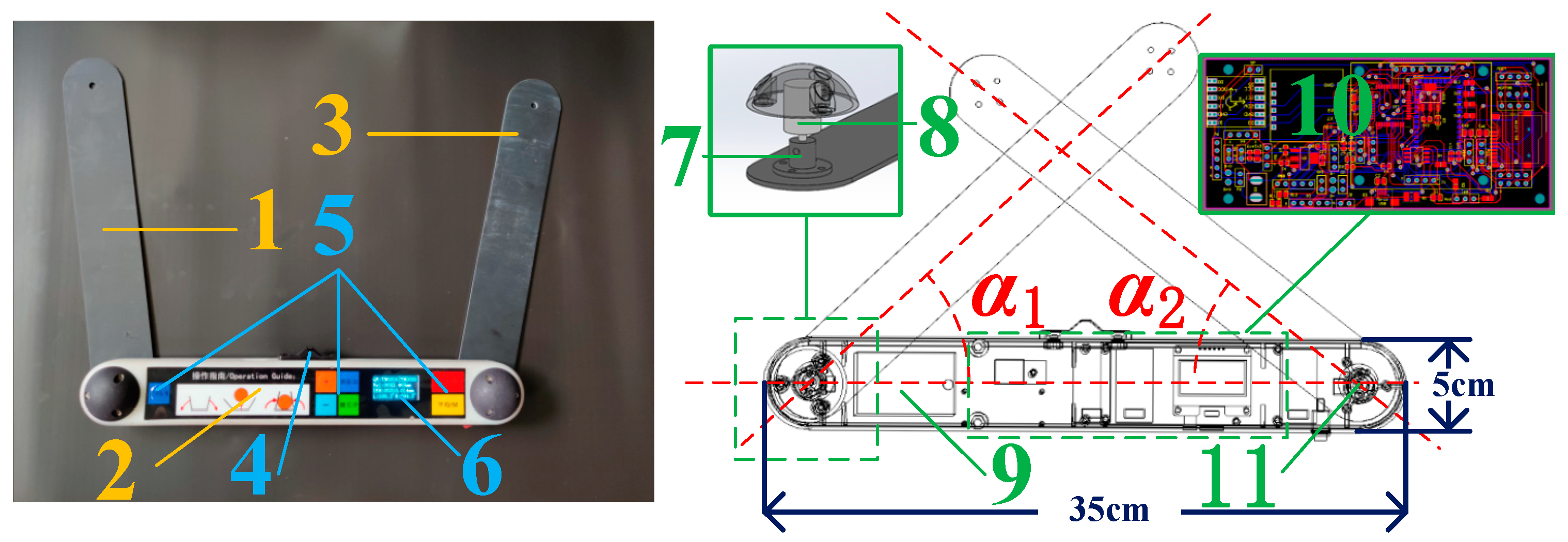

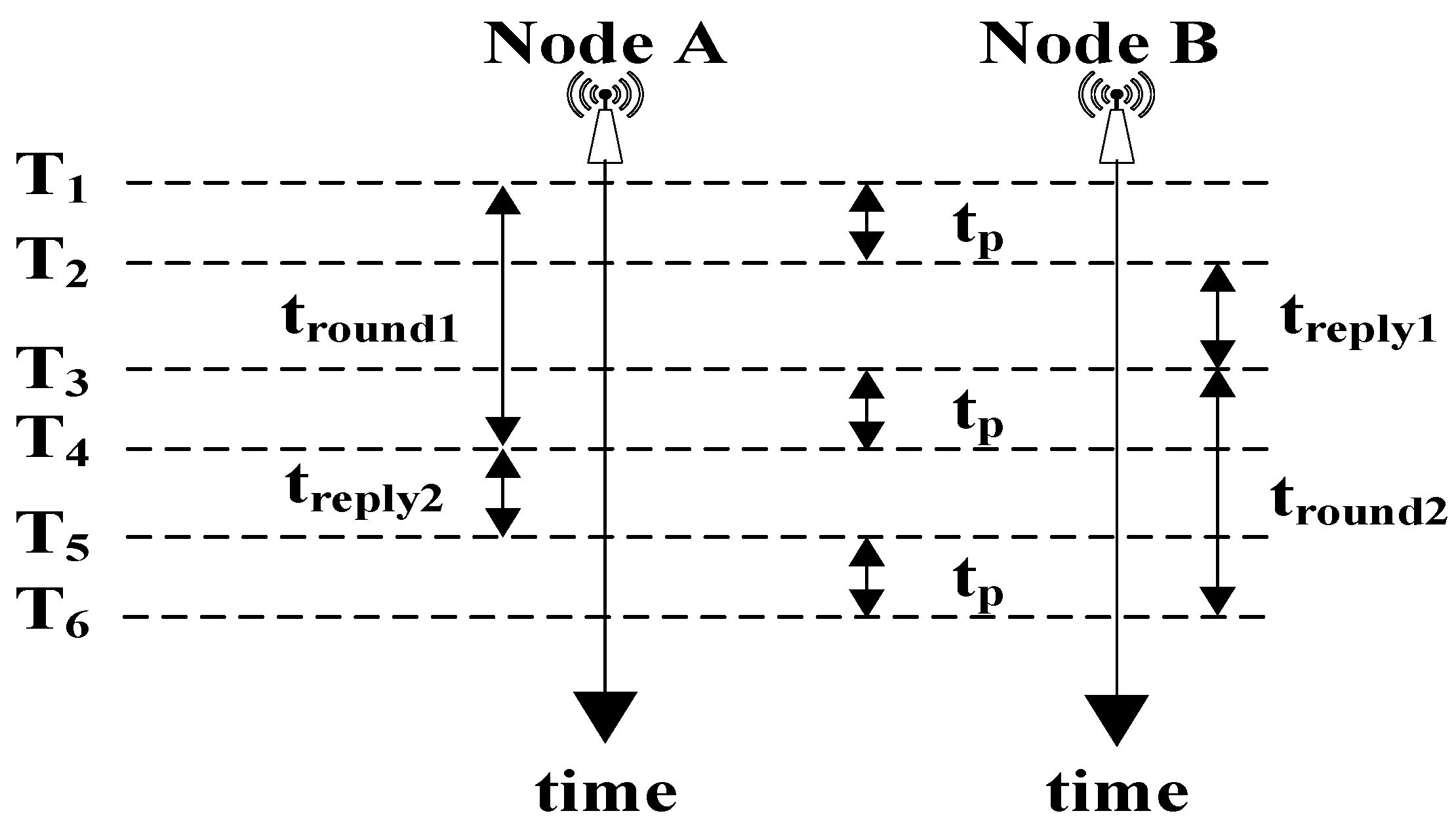
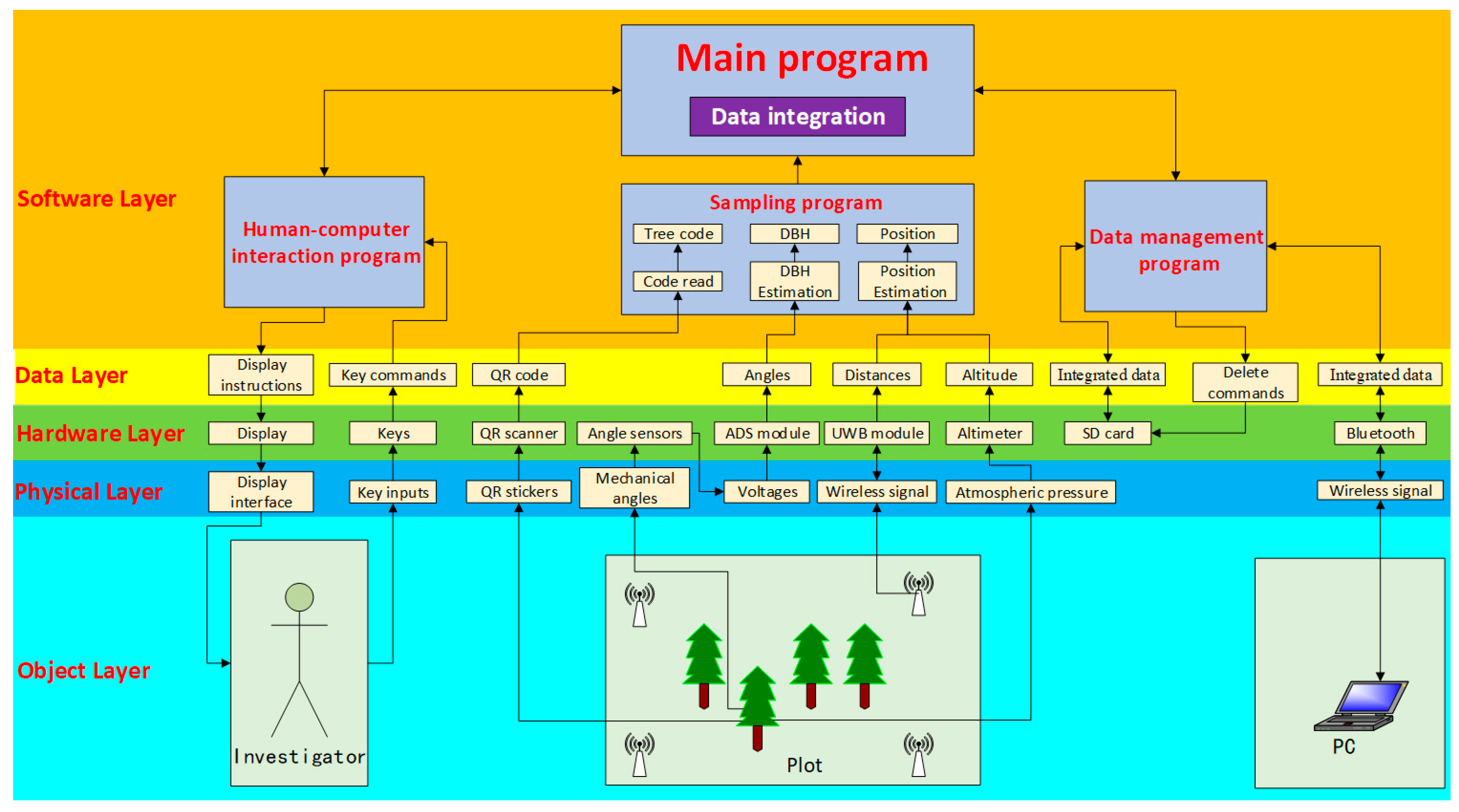
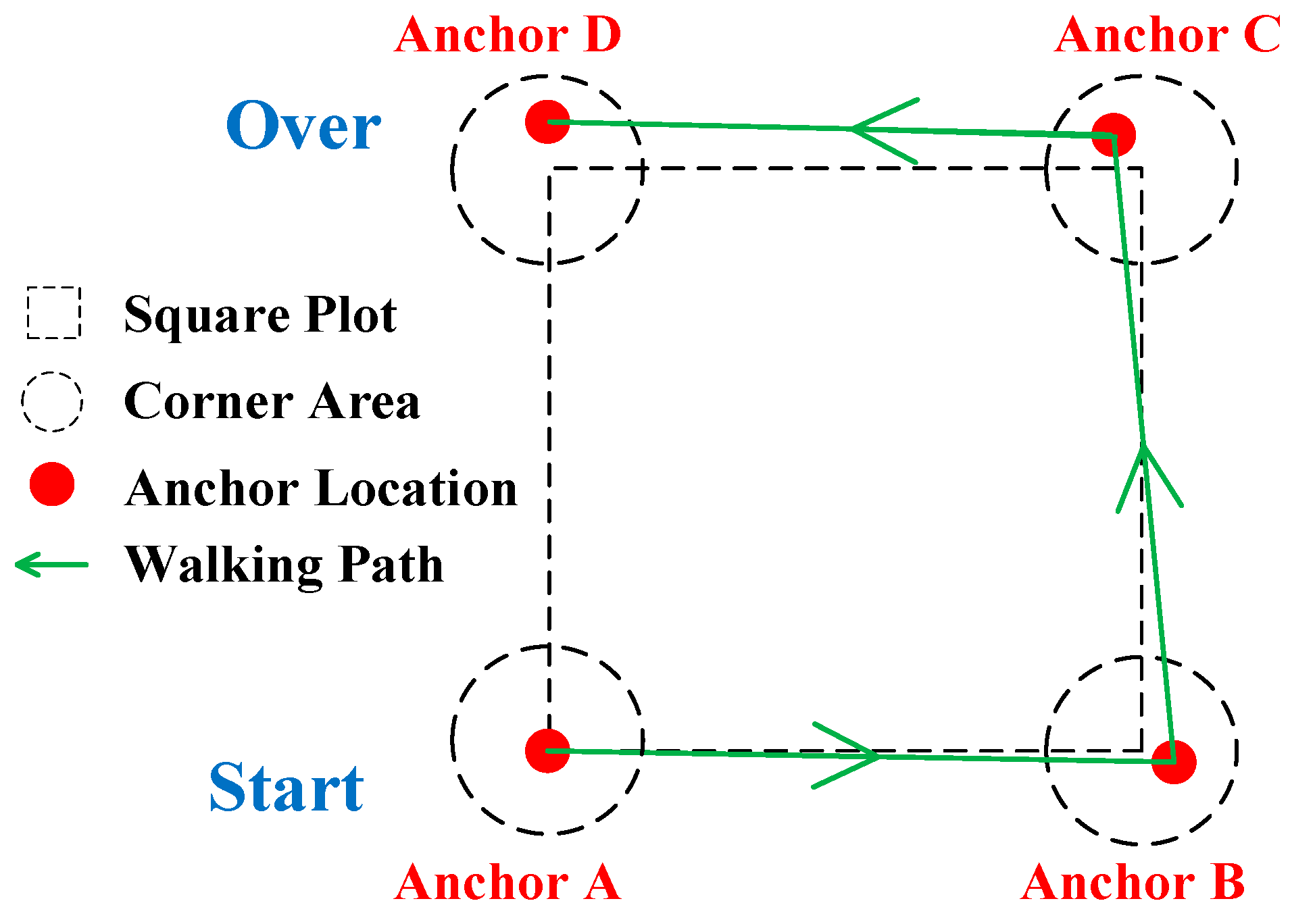
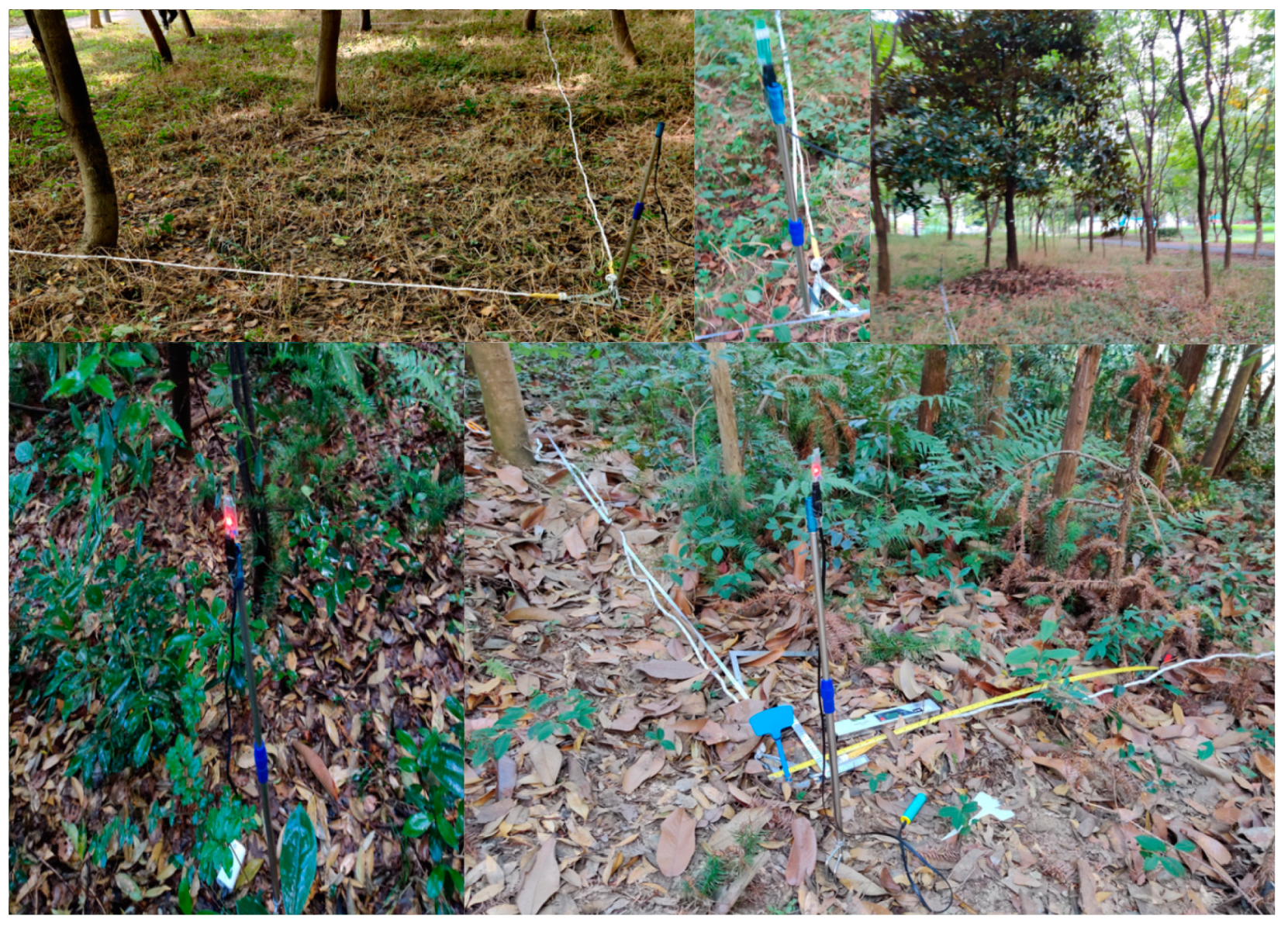
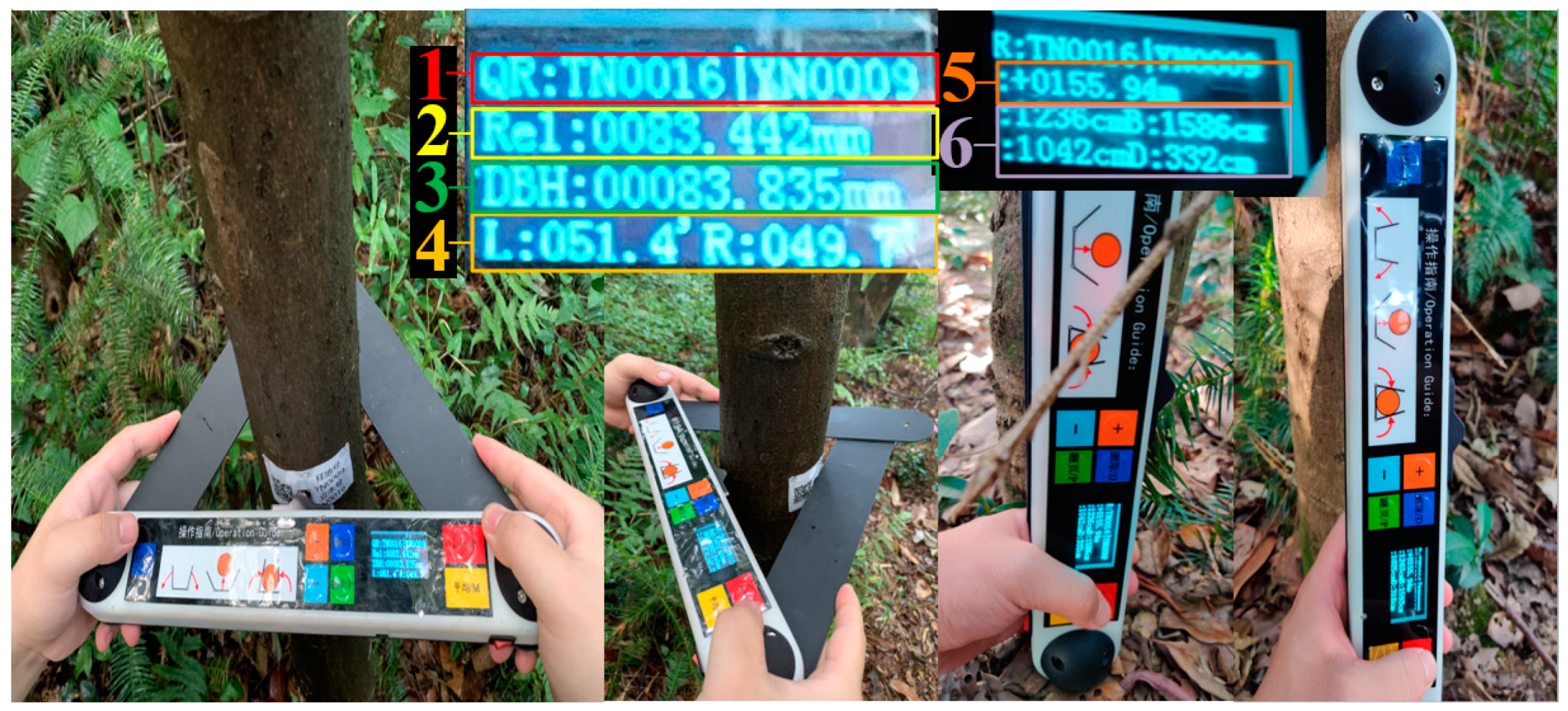
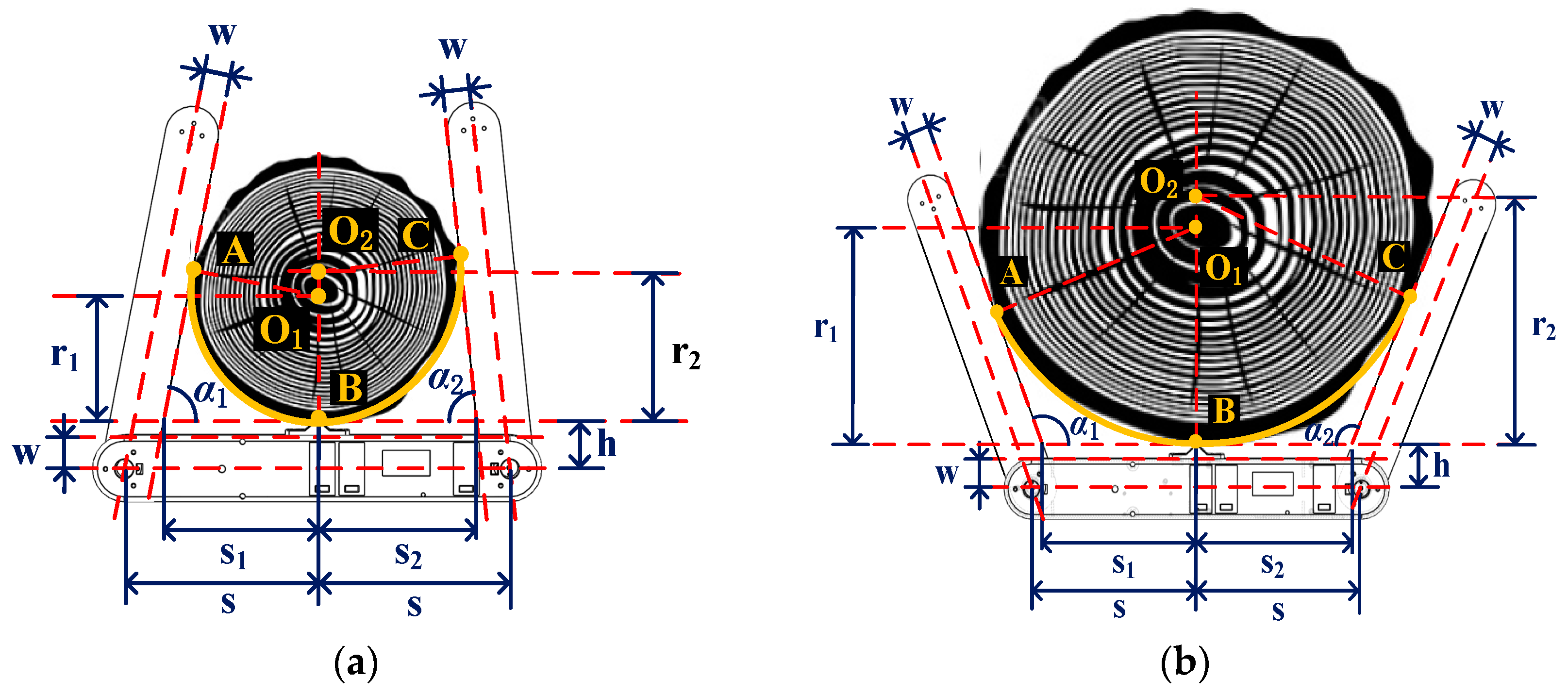

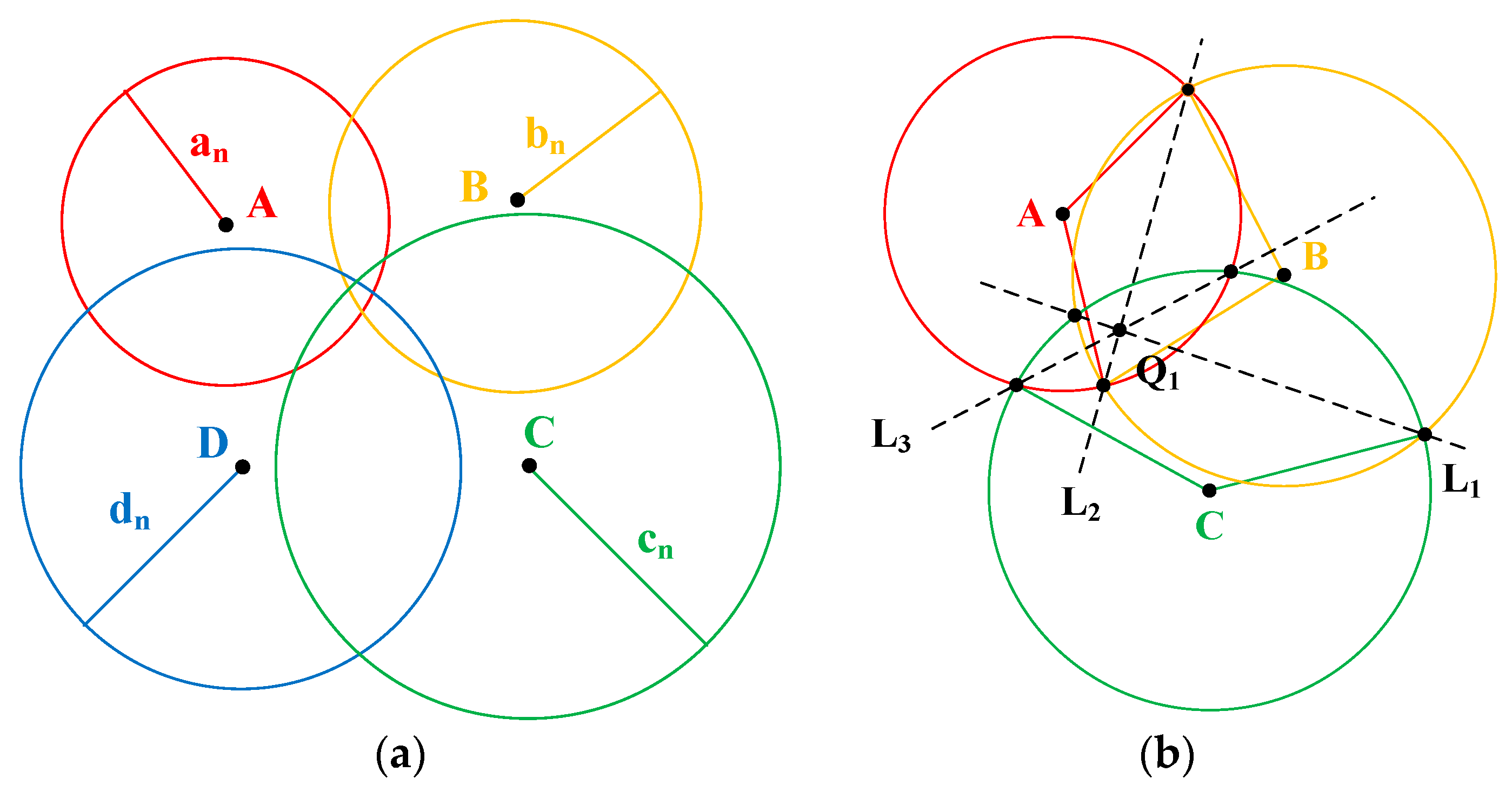
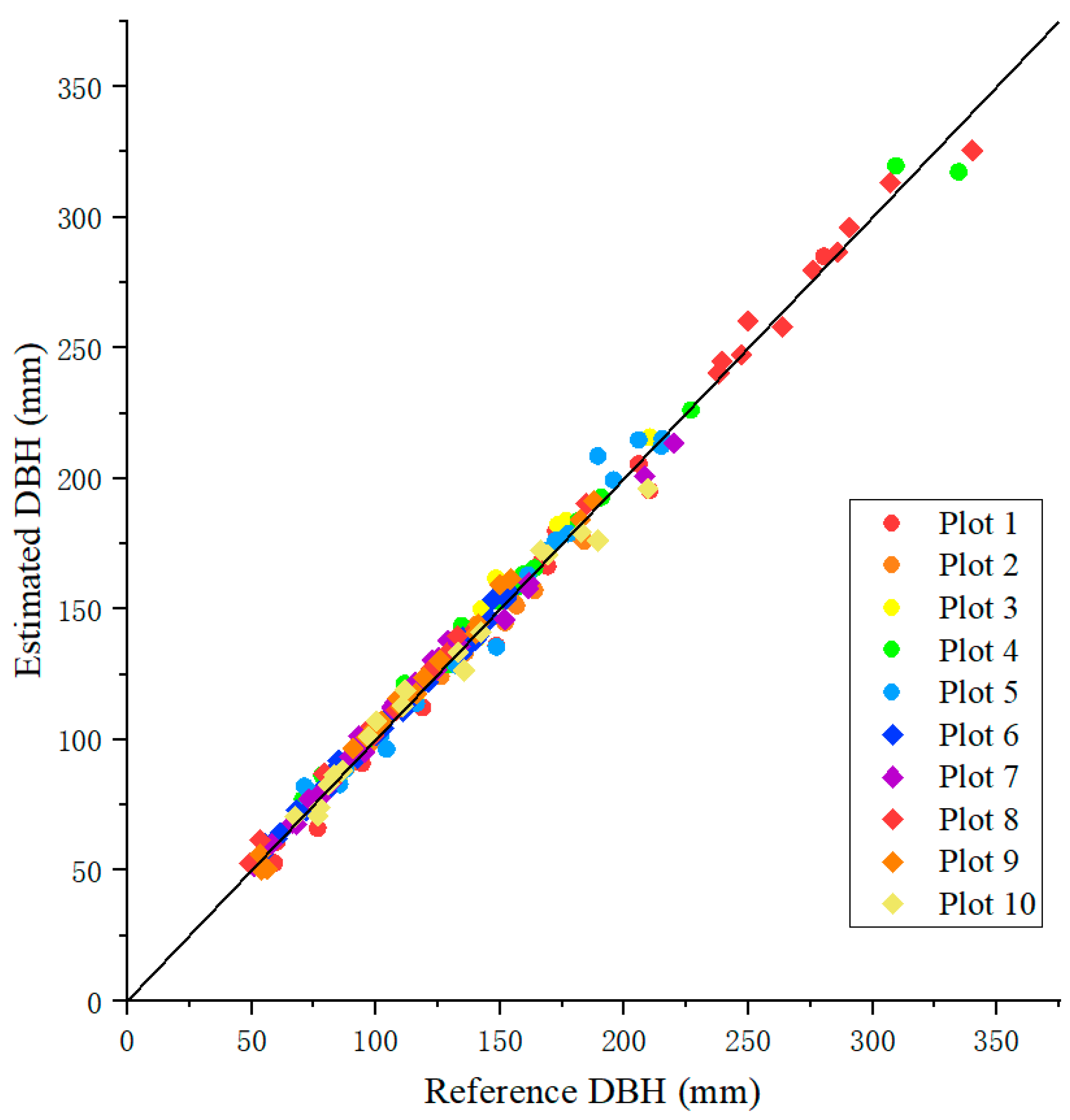
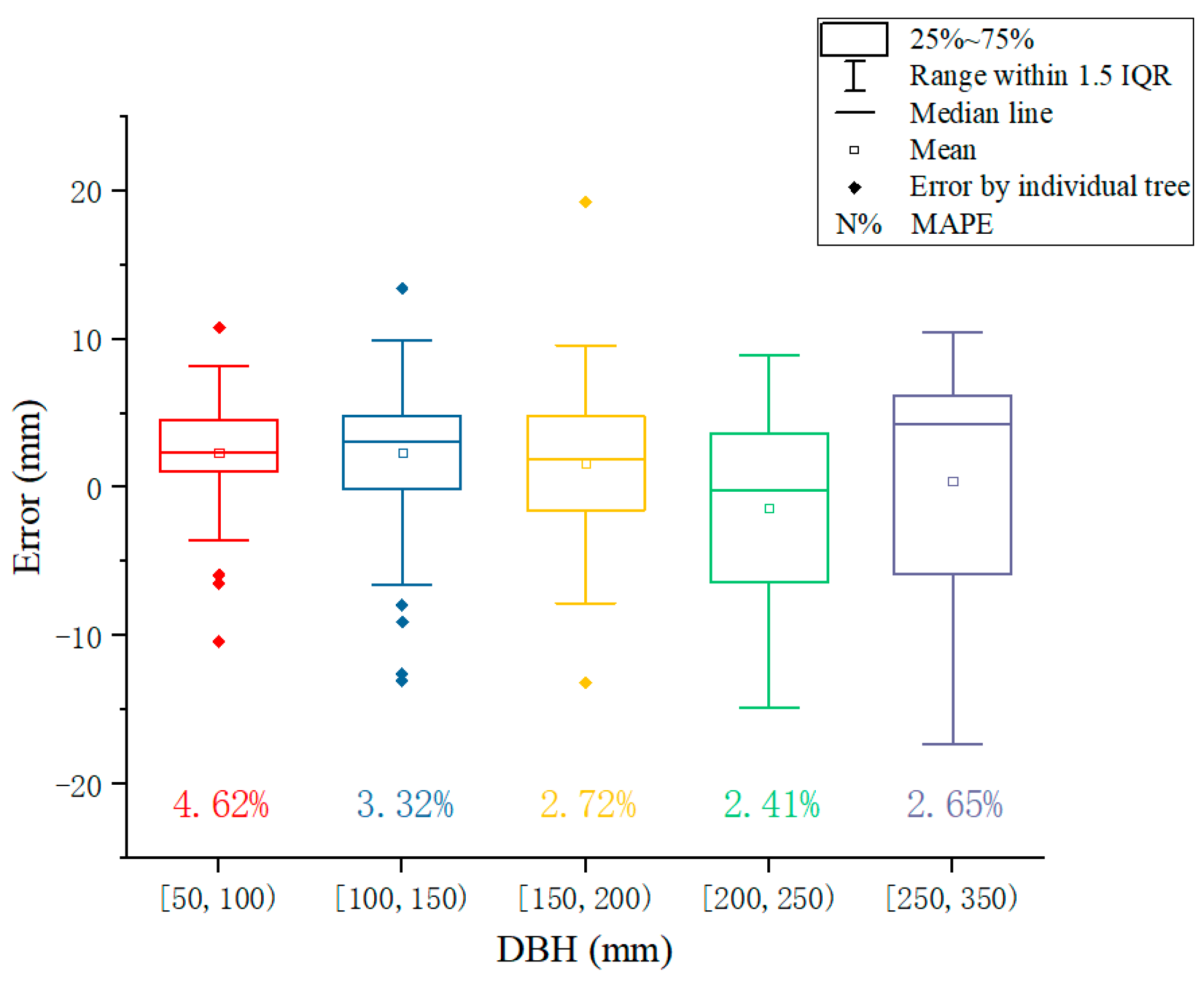

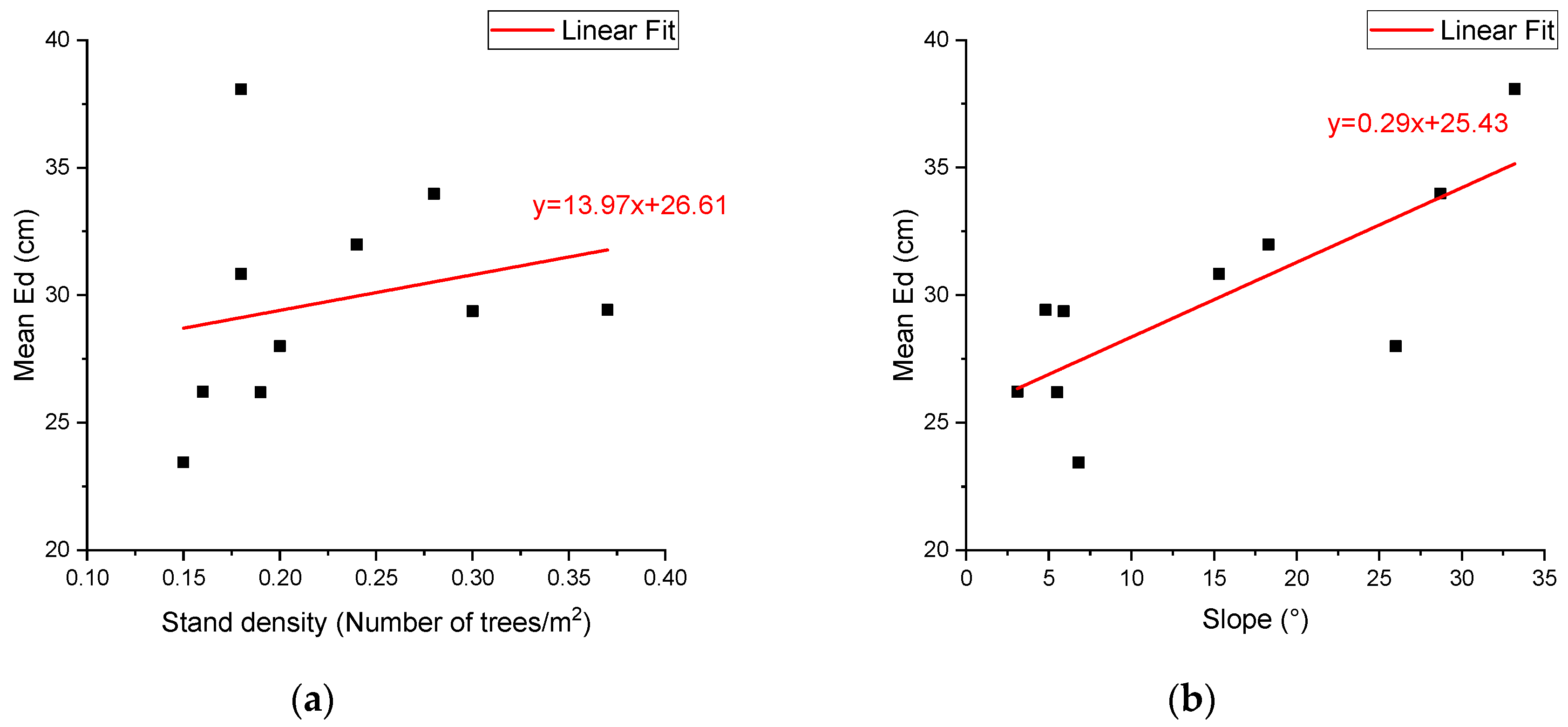
| Component | Chip Model /Type | Interface Type | Parameter | Function |
|---|---|---|---|---|
| Microprocessor | STC15W4K56 | SPI, I2C, Digital, Serial port, etc. | SRAM: 4 KB; Flash: 56 KB; | Data processing |
| QR scanner | M800 | Serial port | Resolution: 20 mil; | QR scanning |
| Analog-to-digital sampling module | ADS1115 | I2C, Analog | 16 bits; 4 channels | AD sampling |
| UWB module | D-DWM-PG1.7 | Serial port | Resolution: 1 cm; Range: 0–50 m | Distance Measurement |
| Altitude sensor | JY901B | Serial port | Resolution: 1 cm | Altitude Measurement |
| Bluetooth | HC-06 | Serial port | Range: 0–15 m | COMM with upper computer |
| SD card | microSD | SPI | 2 GB | Data storage |
| Angle sensor | P3014-V1 | Analog | Resolution: 0.088° | Angle Measurement |
| Display | OLED | SPI | 128 × 64 pixels | Data display |
| Keyboard | PVC | Digital | 7 keys | Command input |
| Power management circuit | TP4056, DW01, AMS1117, etc. | Digital, Power | Input: 3.7–4.2 V, 5 V; Output: 3.3 V, 5 V | Power management |
| Battery | Lithium battery | Power | 4000 mAh | Power supply |
| Plot | Number of Trees | Dominant Species | Slope (°) | DBH (mm) | |||
|---|---|---|---|---|---|---|---|
| Mean | Max | Min | Std | ||||
| 1 | 16 | S1, S2, S3 | 3.1 | 140.31 | 280.32 | 59.29 | 61.29 |
| 2 | 19 | S1, S4 | 5.5 | 136.33 | 183.91 | 83.34 | 28.74 |
| 3 | 15 | S1, S5 | 6.8 | 144.82 | 210.24 | 86.07 | 32.57 |
| 4 | 18 | S2, S3, S6 | 15.3 | 153.72 | 334.63 | 70.54 | 75.13 |
| 5 | 28 | S1, S3, S6 | 28.7 | 125.90 | 215.37 | 67.14 | 49.19 |
| 6 | 37 | S7 | 4.8 | 102.43 | 153.97 | 52.75 | 30.38 |
| 7 | 30 | S7 | 5.9 | 112.91 | 219.90 | 51.19 | 40.16 |
| 8 | 24 | S2, S3, S7 | 18.3 | 179.74 | 340.21 | 52.60 | 88.00 |
| 9 | 20 | S3, S7, S8 | 26.0 | 118.09 | 187.99 | 53.94 | 39.40 |
| 10 | 18 | S7, S9 | 33.2 | 127.31 | 209.57 | 67.67 | 45.60 |
| Plot | BIAS (mm) | relBIAS (%) | RMSE (mm) | relRMSE (%) |
|---|---|---|---|---|
| 1 | −2.04 | −2.04 | 6.65 | 5.76 |
| 2 | −1.22 | −0.64 | 3.52 | 2.29 |
| 3 | 5.13 | 3.50 | 6.44 | 4.43 |
| 4 | 3.34 | 3.54 | 6.84 | 5.27 |
| 5 | 1.87 | 1.85 | 5.94 | 5.01 |
| 6 | 2.40 | 2.65 | 3.48 | 3.85 |
| 7 | 2.33 | 2.53 | 4.79 | 4.11 |
| 8 | 3.33 | 3.17 | 5.93 | 4.96 |
| 9 | 3.25 | 2.41 | 4.72 | 4.77 |
| 10 | −0.62 | −0.25 | 6.42 | 4.76 |
| Total | 1.89 | 1.88 | 5.38 | 4.53 |
| Plot | X (cm) | Y (cm) | ρxy | ||
|---|---|---|---|---|---|
| BIAS | RMSE | BIAS | RMSE | ||
| 1 | 6.51 | 20.21 | −6.40 | 19.72 | −0.22 |
| 2 | −3.97 | 18.45 | −12.07 | 21.73 | −0.26 |
| 3 | 13.65 | 16.82 | 3.67 | 18.44 | 0.13 |
| 4 | 0.26 | 23.54 | −3.86 | 23.06 | −0.21 |
| 5 | 14.88 | 26.59 | −3.75 | 25.17 | −0.12 |
| 6 | −8.19 | 18.05 | 10.58 | 27.94 | −0.09 |
| 7 | −8.55 | 19.37 | 3.19 | 25.12 | −0.11 |
| 8 | 3.36 | 23.93 | −9.57 | 24.03 | 0.04 |
| 9 | −1.89 | 12.94 | 24.69 | 28.43 | 0.23 |
| 10 | −5.50 | 33.96 | −9.63 | 24.71 | 0.30 |
| Total | −0.80 | 21.91 | 1.21 | 24.62 | −0.07 |
| Plot | Ed (cm) | |||
|---|---|---|---|---|
| Mean | Max | Min | Std | |
| 1 | 26.21 | 47.10 | 11.20 | 10.84 |
| 2 | 26.19 | 66.18 | 12.56 | 11.25 |
| 3 | 23.44 | 47.84 | 11.58 | 8.88 |
| 4 | 30.84 | 58.23 | 10.85 | 11.61 |
| 5 | 33.98 | 69.34 | 12.18 | 13.26 |
| 6 | 29.42 | 68.47 | 6.18 | 15.53 |
| 7 | 29.37 | 60.12 | 4.78 | 11.96 |
| 8 | 31.99 | 58.87 | 10.05 | 10.77 |
| 9 | 28.00 | 64.92 | 3.84 | 13.36 |
| 10 | 38.08 | 76.40 | 11.27 | 16.99 |
| Total | 38.06 | 76.40 | 3.84 | 13.53 |
© 2019 by the authors. Licensee MDPI, Basel, Switzerland. This article is an open access article distributed under the terms and conditions of the Creative Commons Attribution (CC BY) license (http://creativecommons.org/licenses/by/4.0/).
Share and Cite
Sun, L.; Fang, L.; Weng, Y.; Zheng, S. An Integrated Method for Coding Trees, Measuring Tree Diameter, and Estimating Tree Positions. Sensors 2020, 20, 144. https://doi.org/10.3390/s20010144
Sun L, Fang L, Weng Y, Zheng S. An Integrated Method for Coding Trees, Measuring Tree Diameter, and Estimating Tree Positions. Sensors. 2020; 20(1):144. https://doi.org/10.3390/s20010144
Chicago/Turabian StyleSun, Linhao, Luming Fang, Yuhui Weng, and Siqing Zheng. 2020. "An Integrated Method for Coding Trees, Measuring Tree Diameter, and Estimating Tree Positions" Sensors 20, no. 1: 144. https://doi.org/10.3390/s20010144
APA StyleSun, L., Fang, L., Weng, Y., & Zheng, S. (2020). An Integrated Method for Coding Trees, Measuring Tree Diameter, and Estimating Tree Positions. Sensors, 20(1), 144. https://doi.org/10.3390/s20010144





